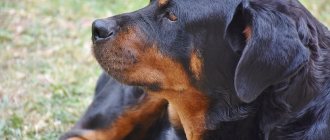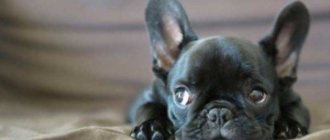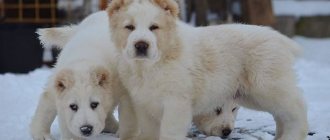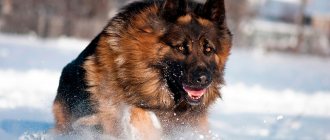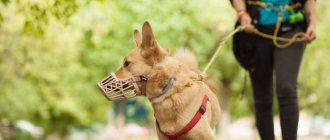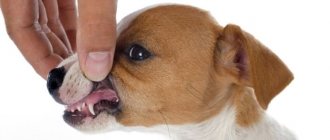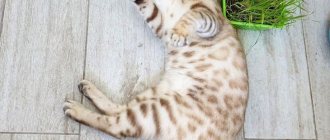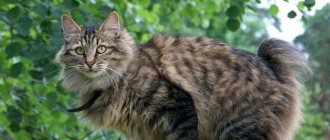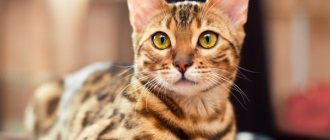Breed traits
Breed traits (on a 5-point scale)
| French Bulldog | |||
| Activity | in the house | 2.3 | |
| on the street | 2.4 | ||
| Obedience | training | 2.6 | |
| strangers | 3.1 | ||
| Domination | in family | 1.4 | |
| over dogs | 3.2 | ||
| Defending your territory | from people | 1.2 | |
| from dogs | 3 | ||
| Sociability | in family | 5 | |
| with strangers | 4.8 | ||
| with dogs | 3.8 | ||
| Concentration | in family | 1.1 | |
| in front of strangers | 1.2 | ||
| with dogs | 1.7 | ||
| Aggressiveness | in family | 1.1 | |
| to strangers | 1.2 | ||
| to the dogs | 2.7 | ||
| to cats | 2.6 | ||
| Family behavior | calmness | 3.2 | |
| demand for affection | 4.4 | ||
| excitability | 3.3 | ||
| playfulness | 4.2 | ||
| excessive barking | 1.8 | ||
| behavioral breakdowns | 1.7 | ||
| Tolerance for children | up to 4 years | 4.2 | |
| over 4 years old | 4.3 | ||
| Institutional use | watchman | 3.3 | |
| bodyguard | 1.3 | ||
This breed is often compared to the following dog breeds: Beagle, Pembroke Welsh Corgi, Jack Russell Terrier, Pug, English Bulldog.
Height and weight
The weight of a male French bulldog is from 9 - 14 kg, an adult female is 8-13. Excess weight in the range of 300-500 g, subject to the preservation of the breed type. The height of a female is 23-32cm, that of a male is 26-35cm, deviations from the boundaries of 1 cm are allowed.
Please see the chart for a clear picture of size, age and weight. Usually a puppy grows up to a certain age, and then the growth goes into width and muscle gain, the weight after this period will not change significantly.
There is such a thing as a “dwarf French bulldog”; this dog does not exceed 8 kg, the individual does not gain enough weight and develops more miniature, such dogs are considered a deviation from the norm.
French bulldogs: general characteristics of the breed
French bulldog named Hammer
Despite their origin and ferocious appearance, these animals are very good-natured and sociable. This is a decorative dog, suitable for keeping in a city apartment. Does not require special care, gets along easily with all family members and other animals. The popularity of French bulldogs is explained by the following characteristics:
- they do not need much physical activity, walking is enough;
- rarely bark, non-aggressive;
- very attached to all family members;
- unpretentious, adapt to any conditions;
- small stature suitable for keeping in a small apartment;
- friendly and cautious by nature;
- can be an ideal companion for a lonely pensioner;
- do not require special care;
- trainable, very smart;
- there is a protective instinct;
- life expectancy 10-12 years.
Relaxing in the grass
But the breed has its drawbacks; such pets are not suitable for everyone. They are very sociable and do not tolerate loneliness well, which can cause them to become aggressive. Therefore, it is better not to get such a breed for people who are at work all day. The French Bulldog is also not suitable for a person who loves perfect cleanliness. Many disadvantages include the fact that they shed, can drool, and often suffer from flatulence. The puppy must be trained with patience and persistence. After all, these dogs are smart, but very stubborn and independent.
Walking rules
French bulldogs need to be walked in any weather 2-3 times a day..
The duration of walks depends on the age of the dog. It is better not to walk with small puppies for more than 15 minutes; with an adult dog you can walk for several hours.
You can let your dog off the leash only in places where there is no danger to its life.
While walking, it is worth remembering some rules:
- Give the dog a good run so that it can throw out all its energy, otherwise the bulldog will do it at home.
- If danger arises and large dogs appear, take your pet on a leash
- Avoid hypothermia
- Avoid impurities
History of the breed
For French bulldogs, the history of the breed began in the 19th century in England. The goal of the breeders was to create a companion dog, guard dog and rat hunter for keeping in urban environments. They crossed English bulldogs with pugs, terriers and other decorative pets. Only the smallest representatives of the breeds were used for breeding. Dogs appeared that were bred by artisans to hunt rats.
At the end of the 19th century, the French bulldog breed came to France. Her unusual appearance, mischievous disposition and good-natured character are the reason for her popularity. She became fashionable in high society. Thanks to this, the French bulldog has spread throughout the world. At the beginning of the 20th century, they were recognized as a separate breed and classified as decorative dogs. They became especially popular in America.
Basking in the sun
In Russia, the French bulldog breed was first popular among the nobility. Chaliapin, the royal family, and other famous people had such a pet. But the history of its breeding in our country was not easy. Since the 1920s, this breed has almost disappeared. After all, she was considered elite, pets were expensive. After the war, there was only one French bulldog left in the whole country in Moscow. They began to breed them again only in the 60s.
Flaws
- Complete absence of a tail.
- Any abnormalities of the lips.
- Unpainted eyelids, lips and nose.
- Malocclusion.
- Recumbent ears.
- The teeth are visible from the mouth.
- Cropped ears.
- Non-standard color.
- The tongue is visible when the mouth is closed.
- Light eyes.
- Not descent of the testicles into the scrotum.
Any visible defects are a deviation; based on the severity, a decision is made to exclude them from exhibitions and further use in breeding.
How many dogs do you have?
- 1 (42%, 601 Votes)
- Just about to start one
 (33%, 469 Votes)
(33%, 469 Votes) - 2 (14%, 204 Votes)
- 3 (4%, 58 Votes)
- More than 5 (3%, 49 Votes)
- 4 (2%, 24 Votes)
- 5 (1%, 15 Votes)
Total voters: 1 420
Description of appearance
The French Bulldog is a smaller version of the English Bulldog, but has some unique features in its appearance. The “Frenchman” became as we know him now in the second half of the 20th century. The main features of appearance are erect ears, shaped like the ears of a bat, a naturally docked tail, a snub nose and large eyes.
French bulldog puppy
After looking at photos of French bulldog puppies, many immediately fall in love with this breed. The expressive eyes are a little sad, which gives the muzzle an offended expression. And his big protruding ears make him funny and cute.
According to the international classification, the breed belongs to the decorative dogs, to the group of small Molossians. The breed standard was adopted in the 20th century, but changes were made to the description of the French bulldog several times.
Dimensions
French bulldogs are medium in size. The height at the withers is from 25 to 35 cm. But because of their strong bones and powerful build, the “Frenchies” weigh a lot. Bitches may be smaller in size. Their weight is from 8 to 12 kg, for boys - up to 10-15 kg.
Torso
Dinner
The first impression of them is that of a powerful, lively and strong animal. This is immediately visible from any photo of representatives of the breed. A wide, cylindrical chest, a short neck, slightly widening towards the shoulders, and powerful, prominent muscles make the Frenchman a small Molosser. The height at the withers is slightly less than the height at the rump. The ribs are rounded, the chest is low and wide, and the stomach is tucked.
The back is muscular, short, the topline slopes slightly from the withers to the loin. The tail is short and set low. By nature it is broken and twisted, sometimes downward.
Limbs
French bulldog puppy
The “French” have short, powerful limbs with prominent muscles. The bones are short, all joints are well defined. The elbows are pressed to the body, and the paws themselves are small, the toes are gathered into a ball. When moving, the limbs are parallel.
Because of this structure of the limbs, the “French” have several features:
- from the side the animal appears stooped, since the front legs are slightly shorter than the hind legs;
- likes to lie on his stomach with his hind legs extended;
- can't swim at all.
Head
The massive head has an almost square outline. It is wide, with a convex forehead and a weakly defined occipital protuberance. There is a deep furrow between the clearly visible brow ridges. The nasal bones are shortened, so the stop is sharp.
The entire muzzle of a French bulldog is covered with folds: there are several of them on the nose, and they go to the upper lip, which also hangs down in a wide fold. The lower jaw protrudes slightly forward, but the teeth should not be visible when the mouth is closed. These animals often exhibit overbite, and some puppies are born with a cleft soft palate.
Muzzle
French bulldog puppy
The muzzle is short, slightly upturned. The nose is wide, the nostrils are wide open and directed upward, and the bridge of the nose is short and wide. That's why the nose appears snub-nosed. Because of this feature, many animals breathe heavily, with frequent grunting, and may snore in their sleep.
The ears of dogs of this breed are set wide and high. They are large and shaped like bat ears. Rounded at the ends and turned forward. The French Bulldog's eyes are large, round and protruding. Set wide and low. They are very expressive, their eyes are intelligent and friendly, this can be seen even in the photo.
Wool
The coat is short, thick, fine and smooth. It lies close to the body and has no undercoat. Therefore, the pet does not tolerate frost well. But thanks to these characteristics of the coat, the French bulldog does not cause allergies.
The colors are very diverse: brindle, fawn, spotted, black and white. Unnatural, therefore not standard, blue, chocolate, tricolor. The most common are white French bulldogs, sometimes with spots. Brindle, white with black spots, are also popular. A dark mask on the face is welcome for any color.
Flaws
French bulldog puppy
When breeding dogs, puppies are sometimes born that do not meet the breed standard. Flaws in appearance do not allow them to participate in shows or obtain a good pedigree. Because of them, such animals cannot be used for breeding. Although this does not prevent them from becoming favorite pets and companions of those who do not care whether the dog is purebred or not.
The following qualities are most often included in the description of the shortcomings of representatives of the breed:
- a wide black stripe along the back or many dark spots;
- white areas on paws, light claws;
- long or too short muzzle;
- when the mouth is closed, the tongue or teeth are visible;
- straight bite;
- gray, black or blue eyes;
- smooth topline;
- nose and lips are not black;
- ears are not standing;
- height above 35 cm;
- the coat is harsh or long;
- color blue, pure black or white without spots.
- Boys have almost no sexual characteristics.
Wool
Short-haired, slightly rough-haired.
Standard colors:
- Red – all its shades, with a black painted mask. All black is not standard.
- Fawn – uniform color on the body, lighter on the chest and belly, and on the inside of the thigh. A dark mask is required. White color is not desirable.
- Brindle - on a dark or red background, the stripes are bright, clear, very different from the main color.
White - the color is acceptable if the eyelids, nose and nails are painted. Such individuals are not allowed for breeding and are considered a reject, are deaf, or pass the gene on by inheritance.
Many people believe that light color is a rarity, this is not true - a creamy, white color indicates a deficiency in the fawn gene responsible for color.
Grey, dark chocolate and tri-color colors are excluded from the standard. But there are many such individuals, the only thing they will face is not being allowed into exhibitions. It is not advisable to breed such dogs.
Character and education
The French Bulldog is a balanced, active, intelligent and kind dog. She needs communication, attention and affection. Animals are very sociable and loving. They treat all family members kindly. Very playful, but will never pester. The peculiarity of the French bulldog's character is that it senses the owner's mood; if he is not ready to play, he will move away. But when he is upset about something, they will try to cheer him up and console him.
They can be aggressive or selfish towards other pets. They are individualists and very jealous. On the street they can get into fights with large dogs. They do not get along well with cats.
White French Bulldog
They are usually friendly with children. But it is recommended to ensure that the child does not hurt the pet while playing, otherwise he will snap. You need to teach your child to treat the animal kindly, not to take away toys, and not to pester him when he eats. Relationships with a new family member can be difficult. When a newborn appears in the house where such a pet lives, the dog may be jealous.
These animals become very attached to their owner. They are devoted to him until the end of their lives. When he leaves, they miss him greatly and greet him with joy. They do not tolerate loneliness, they experience it very painfully, they can become sad or get sick. Sociable and kind “French” people are not only with their family, but even with guests or passers-by on the street. After all, they love when people pay attention to them and play with them.
Sometimes these good-natured animals can be selfish and vindictive. They are smart and do not tolerate rude treatment. If you constantly yell at or punish your pet, it can become angry and aggressive. But with a calm, respectful attitude, the French bulldog will become a true friend.
French Bulldog
Thanks to these character traits, French bulldogs have become popular:
- playful, but not intrusive;
- get along well with children;
- not noisy, bark little;
- very loyal to the owner;
- sociable, mischievous and cheerful;
- smart, obedient.
Pets also have disadvantages, but problems can be avoided with proper upbringing. What negative characteristics are typical of the “French”:
- sometimes they are very active, playful, and can turn the whole house over;
- they remember the insult for a long time and can take revenge;
- due to a rude attitude they become aggressive and can bite;
- cannot stand loneliness;
- They can be stubborn and lazy.
Training
These are smart, quick-witted and calm animals with good reactions. They are easy to train and participate in agility and other canine sports. The peculiarity of dogs from the French bulldog breed is that they have a sense of humor. Their mischievous expression can be seen even in the photo.
We need to chew this stick...
You need to be patient when training and raising a French Bulldog. The “French” understand commands, but are in no hurry to carry them out. This is a companion dog and can change its behavior according to the situation. She will obey when she understands why it is necessary.
When training, you should ensure that the pet always follows the command. But this must be done without rudeness or punishment. If you don’t do this at least once, the pet will completely stop obeying. It is important to show the animal who is in charge as early as possible.
After the puppy appears in the house, it must be accustomed to a place, a bowl, and a toilet. These dogs are able to walk at home on a diaper. But even in this case, you still need to walk with your pet. He should know at least the basic commands: “place”, “fu”, “come to me”, “sit”. But the “French” quickly understand many words: “walk”, “bring”, “ball” and others.
What vaccinations are needed and when to do them?
Adult French Bulldog dogs are vaccinated every year against the most basic diseases.
Puppies receive their first vaccination at the age of two months, the second at 6-7 months, and the third at 12 months..
They are vaccinated against parvovirus enteritis, infectious hepatitis, plague, leptospirosis and, without fail, rabies.
Keeping French Bulldogs
The life expectancy of “Frenchies” is 10-12 years, but with proper care they can live longer. To do this, the owner must understand their characteristics and needs. The most important thing is not to leave the animal alone for a long time. You can even take a bulldog with you on a trip; they tolerate transport well. The only warning is that these dogs, due to their physique, quickly overheat. In a hot room they may develop heatstroke.
French Bulldog
You need to keep an eye on your pet while walking. “The French” do not shy away from people, they are very voracious, they pick up from the ground and can take food from a stranger. It is impossible to say for sure how long to walk this dog. Dog handlers recommend at least an hour, but some animals are couch potatoes and some are more active. Therefore, the duration of the walk is determined individually.
Care
It is not difficult to care for such pets. Even a child can be trusted with this. With a good attitude, the dog will become a devoted friend. “The French” are unpretentious and feel great in a small city apartment. They do not require long walks or trips into nature. They do not tolerate cold and heat well, so they live comfortably only in the house.
French Bulldog - appearance
Caring for a French Bulldog includes the usual procedures.
- You need to keep your paws clean, wash them or wipe them with napkins after a walk. Bath completely when dirty, only use special shampoos. Bathing is usually recommended once every 1-2 months.
- The wool does not need to be cut or combed. It is recommended to brush it with a soft brush 2-3 times a week. During shedding, this should be done more often, and the fallen fur should be collected with a damp sponge.
- Once a day you need to examine and wipe your pet's eyes. Due to the fact that they are convex, injuries occur and inflammation can develop. If necessary, the eyes and ears are washed with a cotton pad or special solutions.
- Wipe the folds on the face with a soft cloth every day. Make sure that diaper rash does not appear.
- Teeth are a weak point in dogs of this breed. They wear down quickly and tartar may appear. It is recommended to give your pet treats and chewing bones, and to brush your teeth with special products once a week.
- If an animal walks for at least an hour a day, its claws will wear down naturally. Otherwise, you need to use a nail clipper.
Nutrition
This breed has a high risk of obesity. It is advisable to consult a veterinarian about how much food to give your animal. Two meals a day are usually recommended. For an adult dog without fat deposits, the amount of food should be 3-4% of body weight.
With natural feeding, half of this volume should consist of animal proteins. Usually this is meat, but offal can also be used. Once a week they give fish and egg yolk. The second half is fermented milk products. They are given as a separate feeding. An adult dog should not be given milk. Be sure to include vegetables, fruits, cereals, bran, and vegetable oil in your diet every day. Depending on age and health, the amount of food may be reduced.
French bulldog ears
You can feed your bulldog dry food. It is recommended to choose super-premium or holistic varieties. This food does not cause allergies and contains all the necessary nutrients. It should be designed for medium breed dogs. Veterinarians recommend the following brands of dry food for feeding French bulldogs:
- Brit Care;
- Acana;
- Orijen;
- Arden Grange;
It is easier to feed your pet dry food: the quantity is indicated on the package. It is usually calculated by the weight of the animal - 12-16 g/kg. You need to make sure your dog always has clean water.
Diseases
This breed is artificially bred and the animals are susceptible to many diseases. They are transmitted genetically, so when choosing a puppy you need to be interested in the health of the parents. Most often, the “French” suffer from the following diseases:
- brachycephalic syndrome, which causes pets to grunt, snore and pant;
- clefting or lengthening of the soft palate;
- hip dysplasia causes lameness;
- congenital anomaly of the knee joints;
- allergic reactions;
- pathologies of intervertebral discs develop mainly with age;
- blood clotting disorder;
- excess weight.
Puppies
Only purebred animals are allowed for breeding. They are ready for the appearance of offspring late: boys only by 2 years, girls a little earlier. Artificial insemination is usually used. Complications often occur during childbirth, so a caesarean section is performed.
French bulldog puppy fighting
Puppies are sold 2-2.5 months after birth. By this time, all vaccinations have already been completed and breastfeeding has been stopped. When purchasing, you need to pay attention to ensure that he is healthy, cheerful and playful. It is recommended to study photographs and reviews of breeders. You need to feed a puppy up to 3 months 5 times a day, at 4-7 months - 4 times, then up to a year - 3 times.
The procedure itself
If the breeder decides to dock, then after contacting a veterinarian, one of two methods of surgical intervention will be chosen: compression and cutting off. The first option is considered more humane. The tail is tied with a tourniquet along the docking line, or a tight elastic band is applied. The goal is to cut off blood circulation for a period of two days to a week. After this period, part of the tail dies and falls off. In the second case, the doctor trims the tip of the tail; at three days of age, the cartilage easily gives way. There are a number of rules for the procedure:
- Before surgery, you need to measure the dog's temperature. The norm is 37 - 39.5 degrees. If the animal's temperature is higher, then an infection is likely, and the operation is postponed.
- Before docking, the puppy is not fed for 12 hours.
- The tail can only be cut off with special surgical scissors or a scalpel.
- The area around the tail is shaved and disinfected (5 and 10% iodine solution, medical alcohol).
- The skin is pulled back to the base, and excess vertebrae are cut off in the selected area.
- After circumcision, the wound is treated with iodine, the skin is returned to its place and a pocket is formed, and a couple of stitches are placed on it.
- The wound is disinfected and treated with an antibiotic.
- The stitches can be removed after about a week.
If a puppy's tail is docked at three days of age, no anesthesia is used; the dog is held by hand. If the animal is older, then painkillers are used, for example, Lidocaine. With age, it will be more difficult for your animal to undergo surgery. For example, bulldogs that have reached the age of one month must be securely fixed on the surgical table, securing the jaw.
And adult dogs are docked only under general anesthesia. The method of inhalation of ethereal alcohol-chloroform with neuroplegic is used. A vagolytic is administered intravenously to reduce salivation and secretion of the tracheal mucosa. This will prevent them from entering the respiratory tract. The operation is the same as for puppies. A sterile bandage is attached to the wound.
During the postoperative period, it is necessary to carefully monitor the condition of the sutures. If they separate or bleed, the wound needs to be treated; if symptoms recur, contact a veterinarian.
FAQ
Inexperienced dog breeders and those who just got a puppy often don’t know what to do in simple situations. Most problems can be solved without a doctor.
Is it possible to give bones to a French bulldog?
It is not recommended to give regular bones. Representatives of this breed wear down their teeth quickly. Bone fragments can injure your intestines or cause constipation.
How long do French bulldogs live?
The lifespan of a pet depends on the conditions of keeping, care, and nutrition. If he does not have genetic diseases, and is surrounded by love and care at home, he can live longer than the average 12 years.
Do French Bulldogs need to have their tail docked?
These dogs have a short tail and are not docked from birth.
Why glue puppies' ears?
With proper nutrition, the puppy's ears should stand up by 3-4 months. If this does not happen within six months, they are glued under the guidance of a veterinarian.
Why does my pet snore and grunt?
This is due to the peculiarities of the anatomy of the “French”. Due to the unusual structure of the nose and jaws, a dog can make different sounds when breathing.
Is it possible to keep a bulldog in an enclosure?
The French Bulldog can only be kept indoors. If he lives on the street or in an enclosure, he may die from cold and loneliness.
When is it not carried out?
By and large, there is no need to dock the tail unless there are medical indications for it. The vast majority of bulldogs are born with short tails. Standards in the modern world state that the tail should be short, low set, and does not require additional adjustments. The most interesting thing is that an unusual bulldog with a long tail will be allowed to participate in exhibitions; there is no article in the rules for disqualifying such an animal.
But such an individual may have problems in breeding; not all breeders are ready to breed long-tailed pets; nevertheless, the French bulldog has characteristic features, and a tiny tail is one of them. Therefore, the issue of docking is decided by the owner of the kennel, since after three days the puppies no longer undergo surgery unless there is a medical need.
The “long-tailed” gene is inherited, and if the breeder did not honestly warn the buyer that there was docking, in the future the new owner may be very surprised by the offspring with luxurious tails.
The operation is also not performed if the dog does not feel well, is sick, has a rash on the stomach or a hernia. When the symptoms go away, you can perform the procedure.
How to properly clean your ears?
French Bulldogs have ears that stand upright, with the insides facing forward rather than out to the sides.
Because of this, they are often compared to the ears of bats. Due to their unusual structure, dirt and wax accumulate in the ears, which can lead to various inflammations.
French Bulldogs' ears need to be cleaned at least twice a month..
The inside of the ear is thoroughly wiped with a cotton swab, which can be soaked in hydrogen peroxide or boric alcohol.
This must be done very carefully, making sure that drops from the tampon do not flow into the ear, otherwise the dog may develop otitis media.
Cleaning the ear canals requires great care. This is done with a thin stick, on one end of which cotton wool soaked in boric alcohol is wound.
Under no circumstances should you push the sticks too deep ! This can damage the eardrum and cause the dog to partially lose hearing.
Vitamins for health
For the healthy development of a dog, vitamins are necessary:
- Vitamins E, H, C. Responsible for normalizing the reproductive ability of the body, tidying up the skin and fat metabolism processes.
- Vitamin A. Promotes puppy growth, improved vision and nervous system function.
- Vitamin B9. Allows coat development, prevents anemia, increases hematopoietic processes.
- Vitamin B6. Improves protein metabolism, maintains the optimal amount of hemoglobin.
- Vitamin D. Promotes optimal bone development, takes part in phosphorus-calcium metabolism.
The bulldog's diet includes fish oil and mineral supplements added to the dog's food. With a natural diet, an additional vitamin course may be required. It is better to consult a veterinarian about the usefulness of the products.
Clothes and muzzle
Bulldogs are short-haired dogs with no undercoat. These animals do not tolerate temperature changes well and clothing for them can be a salvation from frost or heat.
In the summer, you can choose light capes made from natural fabrics for your pet . They will cool the dog, protect it from direct sunlight and prevent the fur from fading.
During the cold season, a jumpsuit will be indispensable to protect your dog from freezing. It is better to choose a windproof overalls made of moisture-repellent fabric. The bulldog will feel comfortable in it both in the rain and in strong winds.
You can also purchase boots for your pet that will protect their paws from various injuries, cuts, and in winter from hypothermia. In addition, roads are often sprinkled with reagents that can cause irritation.
A mandatory attribute when walking with a French bulldog is a muzzle. His choice should be approached very responsibly. The muzzle should not cause discomfort to the dog, press, squeeze, or rub.
In it, the animal should breathe calmly, yawn and stick out its tongue.
IMPORTANT!
The muzzle will not allow the dog to pick up and eat something from the ground, because it could be a “treat” with poison, which was specially scattered for baiting stray animals.
Even though French Bulldogs are incredibly friendly animals, they can easily get into a fight if their owner is in danger.
Do not forget that the ancestors of the bulldog are fighting dogs . A muzzle can pacify the animal.
How to trim claws correctly and when?
A French Bulldog's nails need to be trimmed every 3-4 weeks. The first time this is done is three weeks after the puppy is born.
The dog's nails should not be too long, otherwise they will interfere with the animal when walking, which can lead to deformation of the paw.
Bulldogs have non-retractable claws; they are cut to a length at which the dog does not touch the floor with its claw when walking. This is done with a nail clipper, nippers, trimmer - special devices purchased at a pet store.
Human instruments are not suitable for this procedure..
When processing claws, you should be extremely careful and careful, trying not to damage living tissue - the nail bed.
This will cause your pet severe pain, bleeding and fear. To avoid this, you need to take your pet's paw and press down on the pads, thereby lengthening the claws.
Trim 1 mm of the claw at an angle of 45 degrees . After this, file the nails with a dog file.
If the claw bleeds, it should be treated with hydrogen peroxide or a cotton swab moistened with any antiseptic and applied to the wound.
